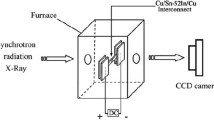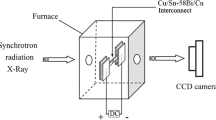Abstract
In situ observation of electromigration (EM) has been carried out on cross-sectioned copper/tin–copper/copper (Cu/Sn0.7Cu/Cu) line-type interconnects. The surface vertical variation after EM is measured by step profiler, which indicates serious mass migration during EM. The EM rate is calculated using two distinct methods, in situ mark movement and the growth of anode intermetallic compounds (IMCs). Defects and IMCs grains in the bulk solder are used as marks to measure the atomic flux. It is calculated that the atomic flux under a current density of 4.77 × 103 A cm−2 and a temperature of 60 °C is 5.241 × 1012 cm−2 s−1. Calculation based on the growth of the anode IMCs layer thickness determines the atomic flux as 4.114 × 1012 cm−2 s−1. The top morphology of IMCs layers is studied by etching away the bulk solder. It is found that the initial scalloped IMCs in the as-reflowed interconnect evolves towards different directions as a serrated IMCs layer with deep grooves forms at the cathode side, while a thick planar IMCs layer forms at the anode side. This phenomenon is defined as polarized evolution. The mechanisms for the polarized evolution rely on the fast diffusion of Cu atoms along the IMCs grain boundaries. The planar IMCs at the anode is due to the stacking of Cu atoms, which fills the grooves by reacting with Sn to form Cu6Sn5 IMCs. This polarized evolution threatens the reliability of interconnects since a thick planar IMCs layer tends to be brittle, while a thin serrated IMCs may suffer from accumulated voids.








Similar content being viewed by others
References
Y.C. Chan, D. Yang, Prog. Mater. Sci. 55, 428 (2010)
Q. Yang, J. Shang, J. Electron. Mater. 34, 1363 (2005)
B. Wu, M.O. Alam, Y.C. Chan, H. Zhong, J. Electron. Mater. 37, 469 (2008)
D. Yang, Y.C. Chan, B. Wu, M. Pecht, J. Mater. Res. 23, 2333 (2008)
L. Zhang, S. Ou, J. Huang, K. Tu, S. Gee, L. Nguyen, Appl. Phys. Lett. 88, 012106 (2006)
H. Gan, K.N. Tu, in 52nd Proceedings on Electronic Components and Technology Conference, 28–31 May 2002, p. 1206. doi:10.1109/ECTC.2002.1008260
B. Chao, S. Chae, X. Zhang, K. Lu, J. Im, P.S. Ho, Acta Mater. 55, 2805 (2007)
J.H. Ke, H.Y. Chuang, W.L. Shih, C.R. Kao, Acta Mater. 60, 2082 (2012)
A. Kumar, M. He, Z. Chen, P. Teo, Thin Solid Films 462, 413 (2004)
B. Chao, S. Chae, X. Zhang, K. Lu, M. Ding, J. Im, S.P. Ho, J. Appl. Phys. 100, 084909 (2006)
B. Chao, X. Zhang, S. Chae, S.P. Ho, Microelectron. Reliab. 49, 253 (2009)
C.E. Ho, C.H. Yang, C.T. Chen, B.Z. Chen, Thin Solid Films 596, 216 (2015)
M.L. Huang, J.F. Zhao, Z.J. Zhang, N. Zhao, Acta Mater. 100, 98 (2015)
M.L. Huang, Z.J. Zhang, N. Zhao, Q. Zhou, Scr. Mater. 68, 853 (2013)
J. Mertens, A. Kirubanandham, N. Chawla, Acta Mater. 102, 220 (2016)
Z. Zhu, H. Sun, F. Wu, Y.C. Chan, J. Mater. Sci. Mater. Electron. 27, 6835 (2016)
W.S. Rasband, in ImageJ. (U.S. National Institutes of Health, Bethesda, 1997–2016), http://imagej.nih.gov/ij/
H. Hsiao, C. Chen, Appl. Phys. Lett. 94, 092107 (2009)
T. Shao, Y. Chen, S. Chiu, C. Chen, J. Appl. Phys. 96, 4518 (2004)
H. Ye, C. Basaran, D. Hopkins, Appl. Phys. Lett. 82, 1045 (2003)
W.K. Choi, H.M. Lee, J. Electron. Mater. 29, 1207 (2000)
Acknowledgements
The authors would like to acknowledge the financial support provided by the National Natural Science Foundation of China/Research Grants Council of Hong Kong (NSFC/RGC), Ref. No. 9054008/N_CityU101/12 (Electromigration and Thermomigration Studies in Nanostructured Composite Electronic Interconnects for Nanoelectronics Applications). We also express our thanks to Dr. Shuyan Zhu in the Optoelectronics Laboratory at City University of Hong Kong for the experimental use of a step profiler. The authors would also like to thank Professor Richard De La Rue, University of Glasgow, Scotland, U.K., for critical review of the paper.
Author information
Authors and Affiliations
Corresponding author
Rights and permissions
About this article
Cite this article
Zhu, Z., Li, Y., Chan, Y.C. et al. Polarized evolution of interfacial intermetallic compounds (IMCs) in interconnects under electromigration (EM). J Mater Sci: Mater Electron 28, 8717–8724 (2017). https://doi.org/10.1007/s10854-017-6596-0
Received:
Accepted:
Published:
Issue Date:
DOI: https://doi.org/10.1007/s10854-017-6596-0




